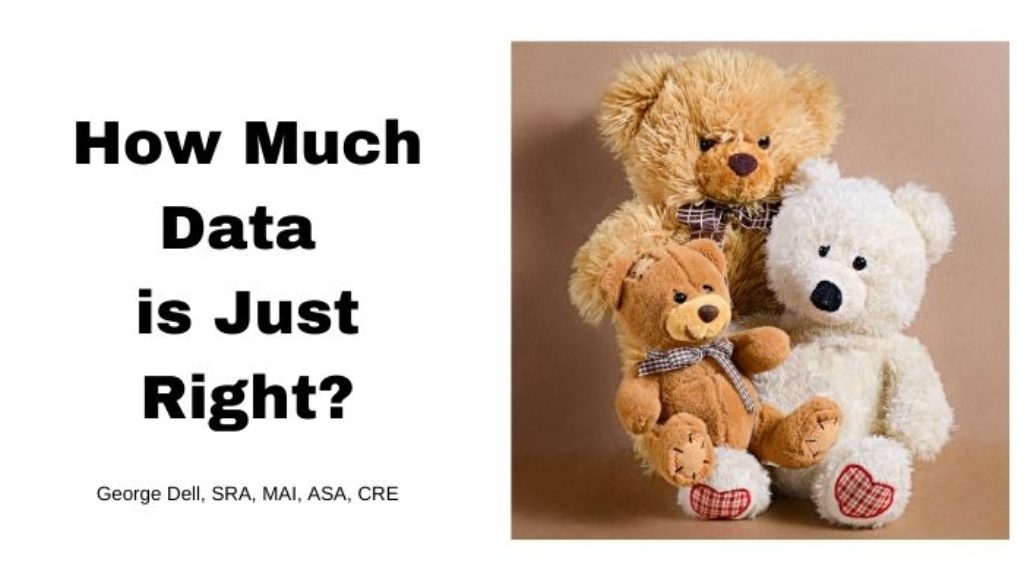We asked about comp selection in a “big data” world. Why do we still use three comps on a form, or six comps on a spreadsheet?
What is the right data?
It has been claimed that three comparables was used because they fit on an 8 ½” by 11” sheet of paper. For commercial work, especially after the discovery of the electronic spreadsheet and sideways printing, 6 or 7 comparables could fit on one sheet nicely.
When I became an appraiser, my trainer liked to collect data “the hard way” with my making calls and investigating sales. It was not possible to collect all the competitive sales. And the data was poor. The best effort was put to confirming and talking to people connected with the transaction. The deeper look at a few comparables created better confidence, and a richer understanding of the market.
Appraisers owned the data. We went to chapter meetings to connect and to exchange comps. We owned the data. Then things changed. First with MLS books, then CompData income property sales, and even some income/rent information – all in print. Then came technology — something called a ‘modem.’ It went beepity-beep at 60 bps. It was cuddly and cute and helpful. Why in less than 20 minutes, you could pull down six or eight sale listings, confirm them, and turn over the file to the typist. In a day or so, you got a draft, edited it with a red pencil, and got the final draft typed.
Confirmation provided a richer understanding and more confident justification and explanation and support of the opinion – an “estimate.” To some extent, the deeper knowledge replaced the wider data set.
So what is the size of the ideal data set?
We have two conflicting theories: More information or garbage data.
More information is always better than less information. Can we simply use more comps? When do we stop? The answer is simple. Any sales competing directly with the subject –exposed to the market – can be called competitive, similar, and comparable.
It is not three, not six, or any given number. The ideal data set includes every sale which was on the market at the same time the subject would have been on the market. If we use less, we are discarding information. If we use more, it may be garbage data.
Once, again Baby bear got it “just right.” Momma bear used the whole neighborhood, and it was “too much.” Papa bear used just three, and it was “too few.” In future posts, we will consider the huge importance of getting it just right . . . and the optimal data set. How do we objectively determine the ideal data set?
This is the foundation stone of Evidence Based Valuation.

February 8, 2017 @ 4:58 pm
Baby Bear here, any number between three, the lender’s minimum and the number of witness, and nine which is the limit of the lender’s reviewer’s patience is just right depending upon what the property is and how many similar properties were on the market during the expected exposure period needed to sell the subject property, which can be obtained from the big data picture.
February 9, 2017 @ 12:05 am
Thank you for the post. I’m looking forward to hearing more about getting it just right.
May 26, 2017 @ 7:10 am
Thanks George for the always great information and thoughts. I like the comment about “exposure to the market”. It lead me to think about new homes that are sold through a builder model office and not listed on MLS. These new homes have only been advertised by the builder in a very limited manner. It seems that the builder can easily create a market for his product without proper exposure. There are always uniformed buyers and once the first couple of sales occur it goes from there. I would like to see some comments on this thought.
June 14, 2017 @ 7:08 pm
Yes, baby bear got it just right! All the competitive sales in the data set, and not one more! 🙂
Charles, thank you for your comments. I suggest you post this one on the forum:
InlandCAAppraisersForum@yahoogroups.com
I am sure different appraisers have different experiences with this, and it would be good to hear some of those ideas.
It does seem to me that developer sales are well advertised, even those not on the local MLS. Yes, developers may have an effect on the market, but that is perhaps just that — an effect on the market as expected. I do not know how to handle the “uninformed buyers” issue in this context. But it is an interesting concept well worth exploring.